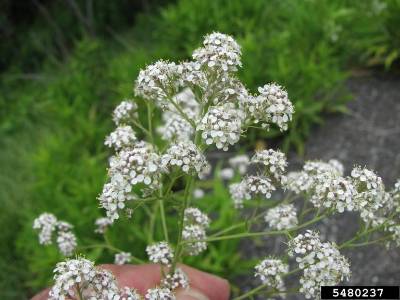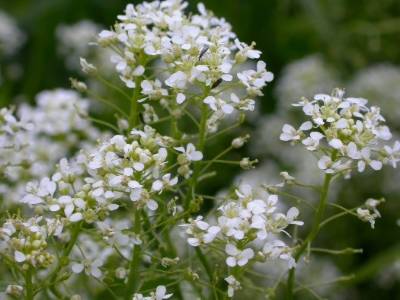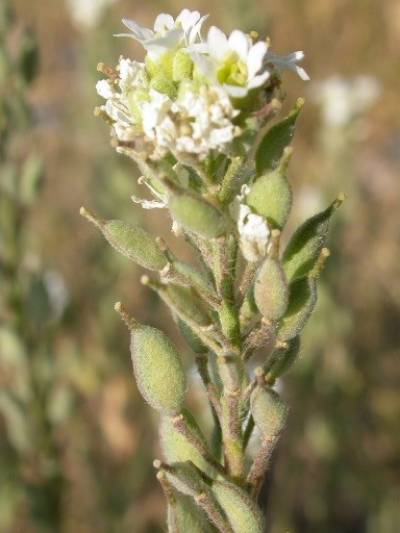Invasive mustards: hoary alyssum, perennial pepperweed, and whitetop

Leslie J. Mehrhoff, University of Connecticut, Bugwood.org

Matt Lavin, MSU.
|
|
Perennial pepperweed- Lepidium latifolium |
Whitetop- Lepidium draba, L. chalepense, and L. appelianum |
Hoary alyssum- Berteroa incana |
|
Growth/ reproduction |
Rhizomatous/seeds and vegetative |
Rhizomatous/seeds and vegetative |
Slender taproot/seeds only |
|
Habitat |
Moist habitats. Alongside streams, rivers, irrigation canals, and sub-irrigated pasture. |
Moist habitats. Sub-irrigated pastures, hay fields, rangelands, roadsides, and ditch banks. |
Dry and disturbed areas. Lawns, pastures, hayfields, vacant lots, and along roadways. |
|
Leaves |
Upper leaves do not clasp the stem. No lobes. |
Upper leaves clasp the stem. Lobed. |
Covered in tiny, star-shaped (stellate) hairs. |
|
Fruits |
Flattened silicles |
Round or inflated silicles |
Round or inflated silicles |
|
Height |
Can reach heights of 6 feet and have woody stems at the base. |
Generally not much taller than knee-high (1-1.5 feet). |
Usually less than 2.5 feet tall. |

Matt Lavin, MSU.
History and status
All of these plants are invasive mustards (Brassicaceae family) native to Europe and/or Asia. Perennial pepperweed is a priority 2A noxious weed in Montana, while whitetop and hoary alyssum are priority 2B, meaning they are more abundant and widespread. The three species in the whitetop complex were in the genus Cardaria, but recent molecular-genetics data indicated that these species are actually within the Lepidium genus (same genus as perennial pepperweed).
Identification
All three plants have small, white flowers with four petals. Key characteristics to differentiate these species from each other include leaves, silicles (fruits), and height (Table, above). Hoary alyssum can be distinguished from perennial pepperweed and whitetop by its tiny, stellate hairs that cover the leaves, notched flower petals, as well as the fruits and stem. Whitetop has upper leaves that clasp the stem, whereas perennial pepperweed does not. Both whitetop and hoary alyssum have round or inflated silicles, while perennial pepperweed has flattened silicles. Whitetop and hoary alyssum are generally not much taller than 2.5 feet, while perennial pepperweed can reach heights of six feet, especially in wetter areas. The three species of whitetop are closely related and can be difficult to distinguish without silicles.
Management
Hoary alyssum reproduces by seed, therefore management should focus on preventing seed production through hand-pulling, mowing, or herbicide applications. Whitetop and perennial pepperweed are rhizomatous, so management is generally more difficult and control techniques must reduce seed production and stress roots. Hand-pulling and mowing are not as effective on these two mustards. Herbicides that contain metsulfuron or chlorsulfuron are effective on all three species, and application should occur rosette to bolting (hoary alyssum) or bud to bloom (whitetop, perennial pepperweed). Grazing is not recommended as all three species exhibit some degree of toxicity to livestock. No biological control agents are currently approved for these species, however agents are being developed for whitetop.
